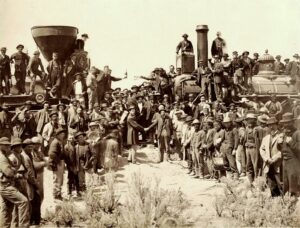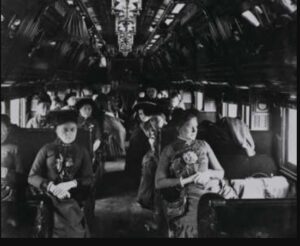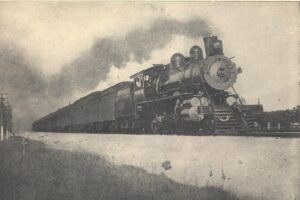 I have taken a number of train rides in my life. I love riding the trains. Some rides were very comfortable, while others are more primitive, with wooden seats, that would not be suitable for a long trip. The transcontinental train was not technically a part of the Gilded Age, when everything was luxurious, but it did feature many of the trapping of that era, and not just in the parlors of the Gilded Age magnates, but in the cars where the everyday travelers would ride too…at least in the first class cars. The cars were adorned with velvet seat cushions and gilt-framed mirrors, and the passengers feasted on antelope, trout, berries, and even champagne. Of course, not every train in 1869 was so elaborately adorned, but then the others were not the Transcontinental Train either. Still, the second-class passengers did have upholstered seats, making their trip not too bad. The third-class, or “emigrant” passengers, paid half of what the first-class passengers did, but they had to sit on benches instead of seats and bring their own food.
I have taken a number of train rides in my life. I love riding the trains. Some rides were very comfortable, while others are more primitive, with wooden seats, that would not be suitable for a long trip. The transcontinental train was not technically a part of the Gilded Age, when everything was luxurious, but it did feature many of the trapping of that era, and not just in the parlors of the Gilded Age magnates, but in the cars where the everyday travelers would ride too…at least in the first class cars. The cars were adorned with velvet seat cushions and gilt-framed mirrors, and the passengers feasted on antelope, trout, berries, and even champagne. Of course, not every train in 1869 was so elaborately adorned, but then the others were not the Transcontinental Train either. Still, the second-class passengers did have upholstered seats, making their trip not too bad. The third-class, or “emigrant” passengers, paid half of what the first-class passengers did, but they had to sit on benches instead of seats and bring their own food.
With the move west, thousands of people flocked to the Transcontinental Railroad beginning in 1869. The  railroad, which stretched nearly 2,000 miles between Iowa, Nebraska, and California, reduced travel time across the West from about six months by wagon or 25 days by stagecoach to just four days. That was an amazing change, and it meant that families that moved west might actually be able to see loved ones they left behind. Prior to that time, moving west could mean saying goodbye forever to the family members who stayed behind. The Transcontinental Railroad represented both the height of modern technology and the tempting possibility of unrestricted travel, although it might take time for people to feel safe with train travel.
railroad, which stretched nearly 2,000 miles between Iowa, Nebraska, and California, reduced travel time across the West from about six months by wagon or 25 days by stagecoach to just four days. That was an amazing change, and it meant that families that moved west might actually be able to see loved ones they left behind. Prior to that time, moving west could mean saying goodbye forever to the family members who stayed behind. The Transcontinental Railroad represented both the height of modern technology and the tempting possibility of unrestricted travel, although it might take time for people to feel safe with train travel.
While the train made it possible to go west much quicker, it wasn’t cheap, nor was it as fast as future forms of travel would be. The first passenger train on the line took 102 hours to travel from Omaha, Nebraska to San Francisco, California, and a first-class ticket cost $134.50, which is about $2,700 today…hardly affordable for a  casual trip. Families might save for years to be able to visit their child, and often only one family member could go at a time. The places the train traveled, were not filled with cities, towns, or even very many homesteads, because at the time, the areas through which the train had been built were not yet open to large numbers of white settlers. In fact, millions of acres of the land the new railroad traversed had belonged to the Native American people, but the US Congress had granted the land to railroad companies. The Native Americans saw this as an intrusion, knowing that behind it would come a wave of white settlers. Nevertheless, the trains and the white man were here to stay.
casual trip. Families might save for years to be able to visit their child, and often only one family member could go at a time. The places the train traveled, were not filled with cities, towns, or even very many homesteads, because at the time, the areas through which the train had been built were not yet open to large numbers of white settlers. In fact, millions of acres of the land the new railroad traversed had belonged to the Native American people, but the US Congress had granted the land to railroad companies. The Native Americans saw this as an intrusion, knowing that behind it would come a wave of white settlers. Nevertheless, the trains and the white man were here to stay.


Leave a Reply